

Unexpected signaling role for foul-smelling hydrogen sulfide in cell response to protein misfolding. Cold Spring Harbor, NY -- Something rotten never smelled so sweet.

This is what members of a team of scientists at Cold Spring Harbor Laboratory (CSHL) are telling one another as they discuss a new finding they did not expect to make. They have discovered that hydrogen sulfide (H2S) – the flammable, highly toxic gas that we usually associate with the smell of rotten eggs in landfills and sewers – plays an important role in the regulation of a signaling pathway implicated in biological malfunctions linked to Alzheimer’s and Parkinson’s diseases, among others. “H2S comes under the category of things that people think of as toxic and nasty, but which can actually be harnessed to serve a useful purpose,” says CSHL Professor Nicholas K. Tonks, FRS, who led the research team. In fact, H2S, which is produced naturally in small quantities in various tissues, is a gasotransmitter, one of a family of gaseous signaling molecules that includes nitrous oxide (NO) and carbon monoxide (CO). Mouse Study Transplants Neurons to Rebuild Brain Circuits.
By Janice Wood Associate News Editor Reviewed by John M.
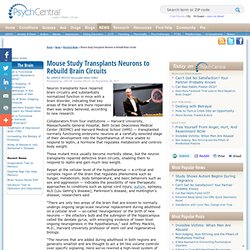
Grohol, Psy.D. on November 29, 2011 Neuron transplants have repaired brain circuitry and substantially normalized function in mice with a brain disorder, indicating that key areas of the brain are more repairable than was widely believed, according to new research. Collaborators from four institutions — Harvard University, Massachusetts General Hospital, Beth Israel Deaconess Medical Center (BIDMC) and Harvard Medical School (HMS) — transplanted normally functioning embryonic neurons at a carefully selected stage of their development into the hypothalamus of mice unable to respond to leptin, a hormone that regulates metabolism and controls body weight. These mutant mice usually become morbidly obese, but the neuron transplants repaired defective brain circuits, enabling them to respond to leptin and gain much less weight. The researchers used a mouse model in which the brain lacks the ability to respond to leptin. 1 neuron, 2 neurotransmitters and different effects on behavior.
Public release date: 8-Nov-2011 [ Print | E-mail Share ] [ Close Window ] Contact: Bryan Ghoshbghosh@plos.org 44-122-344-2837Public Library of Science A team of researchers at The University of Western Ontario has demonstrated that elimination of one of the neurotransmitters in the part of the brain associated with Parkinson's disease may improve brain function without major adverse effects.
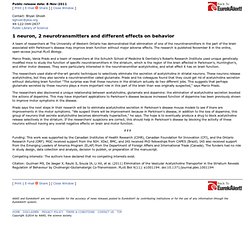
The research is published November 8 in the online, open-access journal PLoS Biology. Mechanism in brain cancer responsible for neuron death discovered. Researchers from Virginia Commonwealth University Massey Cancer Center and the VCU Institute of Molecular Medicinehave discovered a mechanism by which glioblastoma multiforme (GBM), the most common form of brain cancer, promotes the loss of function or death of neurons, a process known as neurodegeneration.

The findings could lead to new therapies that suppress neurodegeneration caused by GBM and, potentially, a variety of other neurodegenerative diseases. The study, recently published in the journal Cancer Research, was led by Paul B. Cancer-causing H. pylori bug spurs cell death. Researchers have figured out how cancer-causing bug H. pylori, which infects half the world’s population, attacks a cell’s innards, causing it to die by self-destructing.

The finding potentially opens the way to more effective treatment of degenerative diseases such as Alzheimer’s disease and Parkinson’s, beside cancers. H. pylori are the only bacteria known to survive in the human stomach, tied with hyperacidity and higher risk of gastric cancer, the second-leading cause of cancer-related deaths worldwide. “More than half the world’s population is currently infected with H. pylori,” said University of Illinois (Urbana-Champaign) microbiology professor Steven Blanke, who led the study. “And we’ve known for a long time that the host doesn’t respond appropriately to clear the infection from the stomach, allowing the bacterium to persist as a risk factor for cancer,” Blanke added, reports the journal Proceedings of the National Academy of Sciences. Programming cells to home to specific tissues may enable more effective cell-based therapies.
Public release date: 27-Oct-2011 [ Print | E-mail Share ] [ Close Window ] Contact: Holly Brown-Ayershbrown-ayers@partners.org 617-534-1603Brigham and Women's Hospital Boston, MA - Stem cell therapies hold enormous potential to address some of the most tragic illnesses, diseases, and tissue defects world-wide.

However, the inability to target cells to tissues of interest poses a significant barrier to effective cell therapy. To address this hurdle, researchers at Brigham and Women's Hospital (BWH) have developed a platform approach to chemically incorporate homing receptors onto the surface of cells. For this new platform, researchers engineered the surface of cells to include receptors that act as a homing device. While conventional cell therapies that include local administration of cells can be useful, they are typically more invasive with limited potential for multiple doses. Scientists identify protein form linked to Huntington's disease. Scientists at the Gladstone Institutes have discovered how a form of the protein linked to Huntington's disease influences the timing and severity of its symptoms, offering new avenues for treating not only this disease, but also a variety of similar conditions.
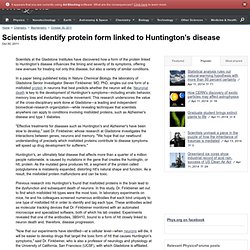
In a paper being published today in Nature Chemical Biology, the laboratory of Gladstone Senior Investigator Steven Finkbeiner, MD, PhD, singles out one form of a misfolded protein in neurons that best predicts whether the neuron will die. Neuronal death is key to the development of Huntington's symptoms—including erratic behavior, memory loss and involuntary muscle movement. This research underscores the value of the cross-disciplinary work done at Gladstone—a leading and independent biomedical–research organization—while revealing techniques that scientists anywhere can apply to conditions involving misfolded proteins, such as Alzheimer's disease and type 1 diabetes. DNA gene find 'transforms' theories on how brain works.
30 October 2011Last updated at 18:31 The genes are responsible for tiny changes in the DNA of brain tissue The genetic make-up of our brain cells changes thousands of times over the course of our lifetimes, according to new research.
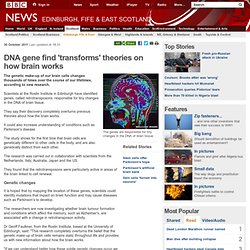
Scientists at the Roslin Institute in Edinburgh have identified genes, called retrotransposons, responsible for tiny changes in the DNA of brain tissue. They say their discovery completely overturns previous theories about how the brain works. New discovery could change the face of cell-biology research. Rewrite the textbooks and revisit old experiments, because there's a new cog in our cellular machinery that has been discovered by researchers from the University of Alberta and the University of Cambridge Institute for Medical Research.
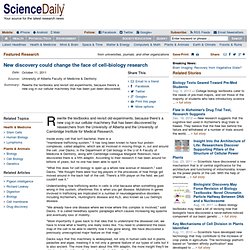
Inside every cell that isn't bacterial, there is a "membrane trafficking system. " It has long been known to have four protein complexes, called adaptins, which are all involved in moving things in, out and around the cell. Effect of aging on the brain. Research by biologists at the University of York and Hull York Medical School has revealed important new information about the way the brain is affected by age.
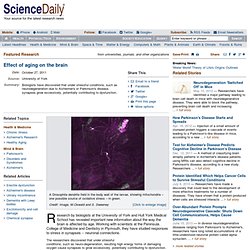
Working with scientists at the Peninsula College of Medicine and Dentistry in Plymouth, they have studied responses to stress in synapses -- neuronal connections. The researchers discovered that under stressful conditions, such as neuro-degeneration, resulting high energy forms of damaging oxygen cause synapses to grow excessively, potentially contributing to dysfunction. Such stresses occur during neurodegenerative disease such as Alzheimer's and Parkinson's Disease. Patient-specific stem cells: Major step toward cell-based therapies for life-threatening diseases. A team of scientists led by Dieter Egli and Scott Noggle at The New York Stem Cell Foundation (NYSCF) Laboratory in New York City has made an important advance in the development of patient-specific stem cells that could impact the study and treatment of diseases such as diabetes, Parkinson's, and Alzheimer's.
As reported in the journal Nature, for the first time the scientists have derived embryonic stem cells from individual patients by adding the nuclei of adult skin cells from patients with type 1 diabetes to unfertilized donor oocytes. The achievement is significant because such patient-specific cells potentially can be transplanted to replace damaged or diseased cells in persons with diabetes and other diseases without rejection by the patient's immune system. The scientists report further work is necessary before such cells can be used in cell-replacement medicine. Neuronal stem cells tracked using MRI: Technology could inform treatment for brain injury and neurological disease. Carnegie Mellon University biologists have developed an MRI-based technique that allows researchers to non-invasively follow neural stem cells in vivo.
The recently patented technology could be used to further the study of neural stem cells and inform the development of new treatments for brain injury caused by trauma, stroke, Parkinson's disease and other neurological disorders. The findings, authored by Associate Professor of Biological Sciences Eric Ahrens and Biological Sciences postdoctoral student Bistra Iordanova, are published online in the journal NeuroImage. Legend had it that once a brain cell dies, it's lost forever. Neuroscientists now know that this is purely myth, having proved that the brain is constantly producing new neurons.
These neural stem cells are born deep in an area of the brain called the subventricular zone. Studying cells in a living brain is problematic. Rather than light, MRI uses magnets to create high-resolution images. Crucial Link Between Prions And ALS Discovered - May Transform Treatment. Lasers light the path to neuron regeneration. Public release date: 19-Sep-2011 [ Print | E-mail. Research offers new way to target shape-shifting proteins. Public release date: 28-Aug-2011 [ Print | E-mail Share ] [ Close Window ] Contact: Abigail Chardabigail@campuspr.co.uk 44-079-604-48532University of Leeds A molecule which can stop the formation of long protein strands, known as amyloid fibrils, that cause joint pain in kidney dialysis patients has been identified by researchers at the University of Leeds.
The discovery could lead to new methods to identify drugs to prevent, treat or halt the progression of other conditions in which amyloid fibrils play a part, including Alzheimer's, Parkinson's and Type II diabetes. The research, funded by the Biotechnology and Biological Sciences Research Council and the Wellcome Trust, is published today (August 28) in Nature Chemical Biology. Holograms reveal brain's inner workings: Microscopy technique used to observe activity of neurons like never before. Like far away galaxies, powerful tools are required to bring the minute inner workings of neurons into focus. Borrowing a technique from materials science, a team of neurobiologists, psychiatrists, and advanced imaging specialists from Switzerland's EPLF and CHUV report in The Journal of Neuroscience how Digital Holographic Microscopy (DHM) can now be used to observe neuronal activity in real-time and in three dimensions -- with up to 50 times greater resolution than ever before.
The application has immense potential for testing out new drugs to fight neurodegenerative diseases such as Alzheimer's and Parkinson's. Neurons come in various shapes and are transparent. To observe them in a Petri dish, scientists use florescent dyes that change the chemical composition and can skew results. Additionally, this technique is time consuming, often damages the cells, and only allows researchers to examine a few neurons at a time. Scientist converts human skin cells into functional brain cells. A scientist at the Gladstone Institutes has discovered a novel way to convert human skin cells into brain cells, advancing medicine and human health by offering new hope for regenerative medicine and personalized drug discovery and development. In a paper being published online July 28 in the scientific journal Cell Stem Cell, Sheng Ding, PhD, reveals efficient and robust methods for transforming adult skin cells into neurons that are capable of transmitting brain signals, marking one of the first documented experiments for transforming an adult human's skin cells into functioning brain cells.
Stanford researchers study how disordered proteins spread from cell to cell, potentially spreading disease.